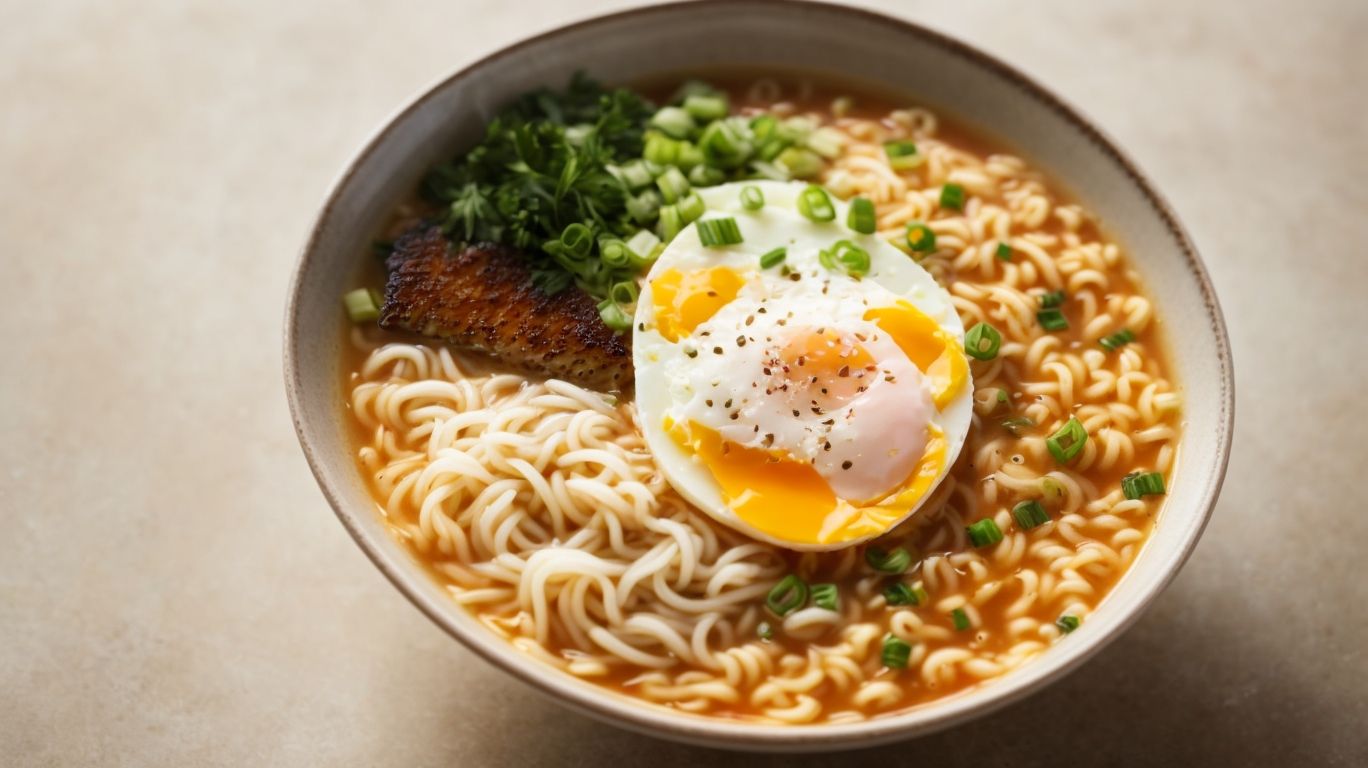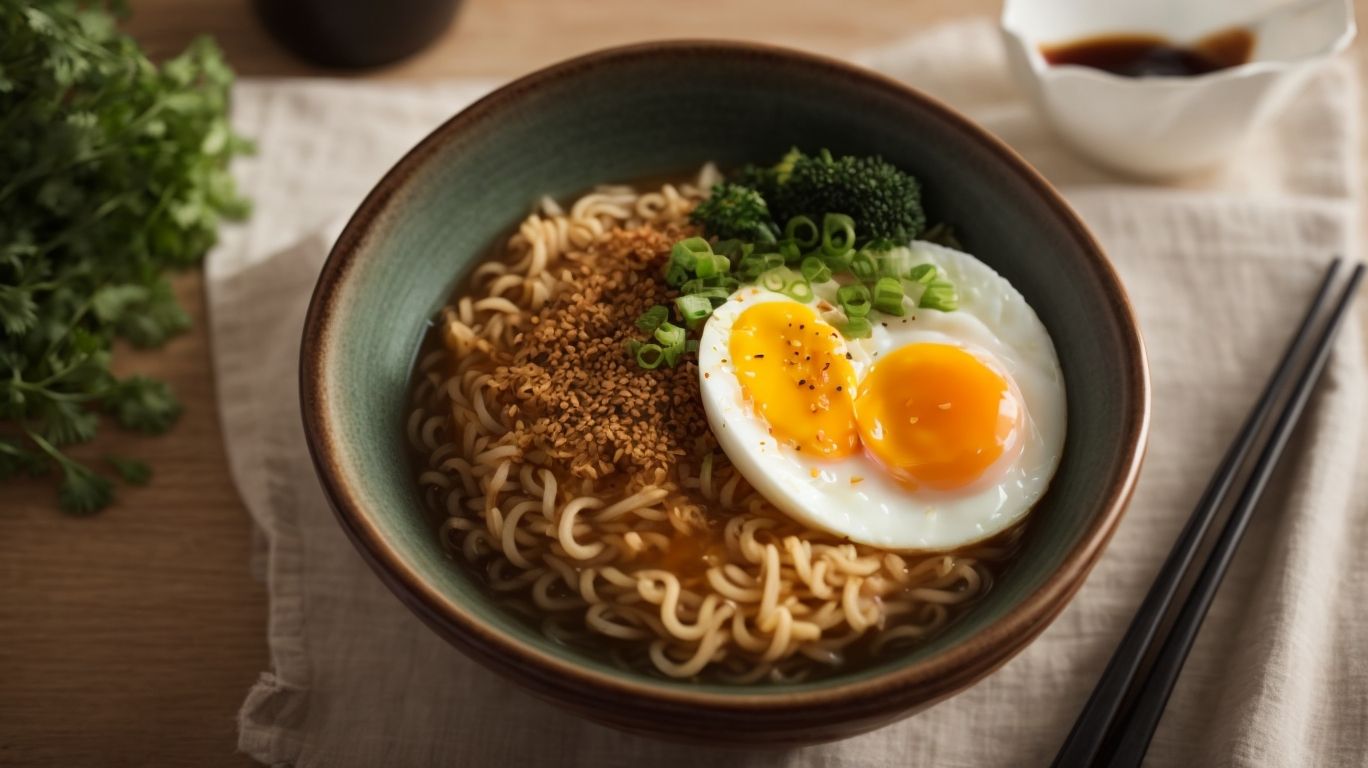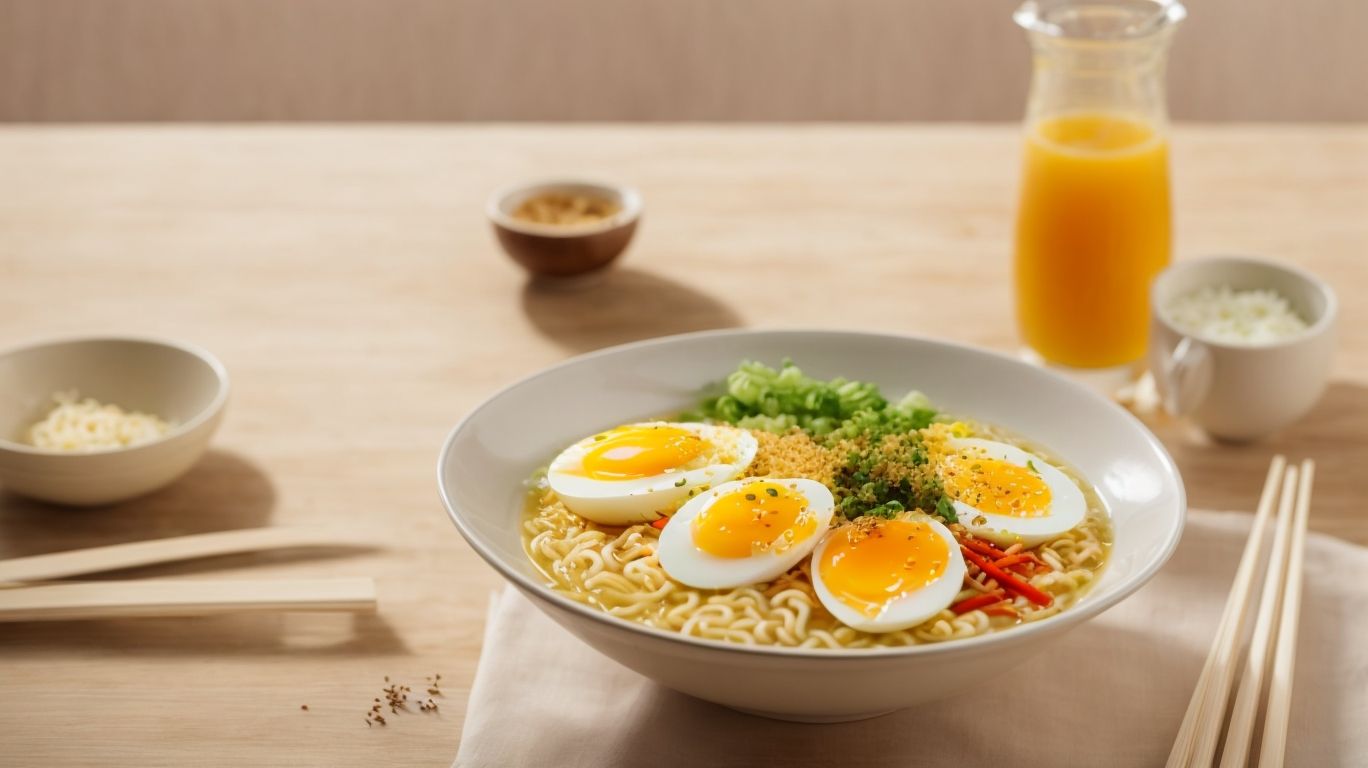How to Cook Egg Into Instant Ramen?
Are you a fan of instant ramen but looking to elevate your dish?
Adding an egg to your instant ramen can not only enhance the flavor but also make it more nutritious and filling.
We will explore the different benefits of adding eggs to instant ramen, the types of eggs that work best, how to cook the perfect egg into instant ramen, and even some creative variations to try.
Stay tuned to learn how to take your instant ramen game to the next level!
Key Takeaways:
What Is Instant Ramen?
Instant Ramen is a convenient and popular type of noodle dish that has gained widespread popularity for its quick preparation and delicious flavors.
Originating in Japan, instant ramen was first introduced by Momofuku Ando in 1958, revolutionizing the food industry with its innovative concept of quick-cooking noodles. The idea stemmed from the necessity for affordable, easy-to-prepare meals during post-war Japan, where traditional ramen was a time-consuming luxury.
Nowadays, instant ramen can be found in virtually every corner of the globe, showcasing a plethora of flavors and styles catering to diverse palates. From the classic chicken and beef flavors to more exotic choices like miso and seafood, there is a variety to suit every taste preference.
The cultural impact of instant ramen extends beyond just a convenient meal. It has become a symbol of globalization, bridging culinary boundaries and introducing people worldwide to the rich traditions of Japanese cuisine.
How Did Instant Ramen Become Popular?
The popularity of instant ramen can be attributed to its convenience, affordability, and diverse flavor options that cater to a wide range of tastes and preferences.
One of the key factors that contributed to the rapid rise of instant ramen is its remarkable shelf-stable nature. Unlike traditional fresh noodles that require refrigeration and have a shorter shelf life, instant ramen noodles are dried and packaged in a way that allows them to be stored for extended periods without compromising their quality.
The ingenious marketing strategies employed by instant ramen manufacturers played a significant role in popularizing this quick and easy meal option. By emphasizing its quick preparation time and flavor variety, instant ramen captured the attention of busy consumers looking for convenient yet satisfying meal solutions.
This culinary innovation has not only revolutionized the way people eat but has also left a lasting impact on global cuisine, influencing the incorporation of Asian flavors and noodle dishes in diverse culinary traditions around the world.
What Are the Benefits of Adding Egg to Instant Ramen?

Credits: Poormet.Com – Peter Martinez
Adding an egg to instant ramen enhances its flavor profile, boosts the protein content, and introduces essential minerals, making the dish both delicious and nutritious.
When you crack a fresh egg into your steaming bowl of instant ramen, you not only elevate the taste to a whole new level but also increase the nutritional value significantly. Eggs are packed with high-quality protein, offering a complete amino acid profile essential for muscle repair and growth. In addition, eggs are a rich source of minerals like iron, zinc, and vitamins such as B12, contributing to better overall health.
Adds Protein
Including eggs in instant ramen increases its protein content, providing essential nutrients like vitamins and minerals necessary for a balanced diet.
Eggs are not just delicious additions to your instant ramen, but they also pack a powerful nutritional punch. Rich in high-quality protein, eggs supply the body with amino acids essential for muscle growth and repair. Along with protein, they are a great source of vitamins such as vitamin D, vitamin B12, and riboflavin, promoting overall health.
Eggs contain essential minerals like selenium, iron, and zinc, which play crucial roles in various bodily functions. By incorporating eggs into your ramen, you elevate the nutritional profile of your meal, making it a more well-rounded and satisfying option.
Enhances Flavor
The addition of eggs to instant ramen elevates its flavor profile by introducing a rich umami taste and enhancing the overall cooking process with creative textures.
Umami, referred to as the fifth taste alongside sweet, salty, sour, and bitter, plays a significant role in elevating the depth of flavors in dishes like ramen. When eggs are added to the broth, they release a savory richness that complements the existing flavors while imparting a creamy consistency.
The texture variations achieved by incorporating eggs into instant ramen add a delightful contrast to the soft noodles. Soft-boiled or poached eggs contribute a velvety texture, while scrambled eggs present a fluffy and light element to each bite, creating an exciting gastronomic experience.
Makes the Dish More Filling
Incorporating eggs into instant ramen enhances its satiety factor, turning the dish into a more substantial and energy-boosting meal.
When eggs are added to instant ramen, they provide a rich source of protein and essential nutrients that help keep hunger at bay for longer periods.
The combination of noodles, broth, and the protein-packed eggs creates a delicious and fulfilling meal that leaves you feeling satisfied and nourished.
Eggs add a creamy texture and savory flavor to the ramen, elevating its overall taste profile and making it a more enjoyable dining experience.
What Type of Egg Should Be Used for Instant Ramen?

Credits: Poormet.Com – Raymond Wilson
The choice of egg for instant ramen can vary between soft-boiled, poached, or fried, each offering a unique texture and flavor profile to complement the dish.
Soft-boiled eggs, with their gooey yolk and slightly firm whites, add a creamy richness to the ramen broth, creating a comforting and indulgent experience.
On the other hand, poached eggs bring a silky and delicate texture, releasing their velvety yolk into the soup, enhancing the overall creaminess and richness of the broth.
Fried eggs, with their crispy edges and runny yolks, provide a contrast of textures and flavors, adding a savory depth to the noodles and broth.
Soft-Boiled Egg
A soft-boiled egg in instant ramen provides a luscious, runny yolk texture that adds a creamy richness to the dish when prepared using the proper cooking method.
One of the most appealing aspects of incorporating a soft-boiled egg into your instant ramen is the delightful interplay of textures it brings to the palate. As you gently crack open the egg, the silky, velvety yolk effortlessly mingles with the savory broth, creating a luxurious mouthfeel that elevates the overall dining experience. The contrast between the oozy yolk and the firm, yet tender egg white enhances not only the texture but also the flavor profile of the dish, transforming it into a more satisfying and well-rounded meal.
Poached Egg
A poached egg in instant ramen offers a delicate and velvety texture, requiring precise cooking in simmering water to achieve the desired flavor and consistency.
When preparing a poached egg for your ramen, the key is to use fresh eggs at room temperature to ensure a perfect cook. It’s crucial to crack the egg gently into a cup or ramekin before carefully sliding it into the simmering water. The ideal water temperature for poaching ranges between 160-180°F, as boiling water can cause the egg whites to toughen too quickly.
Fried Egg
A fried egg atop instant ramen introduces a crispy texture and savory notes, requiring high heat and proper ingredient selection to achieve a perfect balance of flavors.
When preparing this flavorful dish, start by heating a small amount of oil in a skillet over medium-high heat. Carefully crack an egg into the hot pan, making sure not to break the yolk. Allow the egg white to set slightly before gently flipping it to cook the other side, aiming for a slightly runny yolk.
For the instant ramen base, choose a broth flavor that complements the richness of the fried egg, such as miso or pork. Add in the noodles and let them cook until just tender, then transfer the ramen to a bowl.
The final step involves carefully placing the fried egg on top of the steaming ramen, allowing its warm, runny yolk to mix with the broth and enhance the overall taste experience. Sprinkle some chopped green onions or a dash of soy sauce for an added layer of flavor and visual appeal.
How to Cook Egg into Instant Ramen?
Cooking eggs into instant ramen is a straightforward process that involves strategic timing, proper ingredient incorporation, and gentle stirring to achieve a harmonious blend of flavors and textures.
Prepare your instant ramen noodles by boiling them in water until they are just tender. While the noodles cook, crack an egg into a small bowl, ensuring not to break the yolk. Slowly pour the beaten egg into the simmering broth of the ramen, allowing it to gently cook without disturbing the noodles. You can also add other ingredients like vegetables or protein at this stage.
Preparing the Instant Ramen
Preparing the instant ramen involves boiling water, adding the noodles and flavoring packet, and cooking until the noodles reach the desired consistency for a delicious base.
Bring a pot of water to a rolling boil. This step is crucial as it ensures that the noodles cook properly and the flavors meld well.
Once the water is boiling, carefully add the noodles to the pot. Ensure that the noodles are submerged and have enough space to move freely. Let the noodles hydrate by simmering gently to achieve that perfect texture.
Preparing the Egg
Preparing the egg for instant ramen involves selecting the desired cooking method, ensuring proper doneness, and incorporating soft-cooked elements to enhance the dish’s overall appeal.
One common cooking technique is to soft-boil the egg by bringing a pot of water to a gentle boil, carefully lowering the egg in, and cooking it for about six minutes to achieve a runny yolk and tender whites.
Another option is to poach the egg directly in the simmering broth of the ramen, ensuring a silky texture that complements the noodles perfectly.
For those who prefer a firmer texture, hard-boiling the egg before slicing it and laying it delicately on top of the steaming bowl is also a popular choice.
Adding the Egg to the Instant Ramen
Adding the cooked egg to the instant ramen involves incorporating it into the broth, gently stirring to distribute flavors, and unleashing creative variations to elevate the dish.
Once the egg is cooked to your desired consistency, carefully slide it into the piping hot broth, taking care not to break the yolk for that perfect creamy texture. Gentle stirring in circular motions ensures the egg blends harmoniously with the noodles and seasonings, infusing every bite with rich, velvety goodness. To enhance the experience, consider topping your ramen masterwork with a sprinkle of sesame seeds for a subtle crunch or a drizzle of chili oil for an added kick.
Tips for Cooking the Perfect Egg in Instant Ramen
Achieving the perfect egg in instant ramen requires attention to detail, precise timing, and incorporating complementary ingredients like scallions to enhance the dish’s visual appeal and taste.
For the perfect soft-boiled egg, ensure you time it precisely — around six minutes for a slightly runny yolk or up to eight minutes for a firmer yolk. Pairing the egg with textured elements like scallions not only adds flavor and crunch but also elevates the overall presentation of the dish.
- Experiment with different ingredient combinations such as soy sauce, sesame oil, or chili flakes to customize your instant ramen to suit your taste preferences.
- When garnishing your ramen, consider adding fresh herbs like cilantro or Thai basil for a burst of freshness that complements the richness of the egg.
Other Variations of Egg in Instant Ramen

Credits: Poormet.Com – Gregory Lewis
Beyond traditional egg preparations, other creative variations in instant ramen include egg drop ramen, cheesy ramen carbonara, and indulgent ramen omelettes, offering diverse meal experiences.
For a comforting and soothing meal, egg drop ramen stands out with its delicate balance of flavors and textures. The egg is gently swirled into the hot broth, creating beautiful ribbons of protein that enhance the overall richness of the dish.
For a decadent twist, try the ramen carbonara with cheese, a fusion of Italian and Japanese influences that results in a creamy, cheesy delight.
And if you’re feeling adventurous, whip up a flavorful ramen omelette by folding ramen noodles and a fragrant mix of veggies into a fluffy egg base for a unique culinary experience.
Egg Drop Ramen
Egg drop ramen involves gently whisking eggs into the simmering broth, creating delicate ribbons of cooked egg that enhance the overall eating experience with their silky texture and visual appeal.
For the perfect egg drop ramen, the key is to whisk the eggs vigorously in a separate bowl before pouring them slowly into the hot broth. This ensures that the eggs evenly disperse and form those satisfying strands. Broth integration plays a crucial role as well. The flavorful broth should be rich and well-seasoned to complement the mild egg flavor.
As you taste a spoonful of this comforting dish, the sensation of the silky egg strands intertwining with the noodles is truly delightful. The sensory experience is heightened further with each bite as the flavors harmonize on your palate, making egg drop ramen a comforting and satisfying meal option.
Ramen Carbonara
Ramen carbonara is a fusion dish that combines the creamy richness of eggs and cheese with the comforting appeal of ramen noodles, resulting in a decadent and delicious meal experience.
Traditionally, carbonara sauce is made by mixing eggs, cheese, pancetta, and black pepper, creating a silky and flavorful coating for pasta. In the case of ramen carbonara, this Italian classic gets a Japanese twist by substituting spaghetti with springy ramen noodles. The marriage of the umami flavors from the bacon-like pancetta and the distinct bite of Parmesan cheese with the unique texture of ramen creates a symphony of taste sensations that elevates this dish to a whole new level.
Ramen Omelette
Ramen omelette features a fluffy egg base infused with ramen noodles and savory fillings, offering a textural contrast and incorporating fresh scallions for a burst of flavor in every bite.
Creating the perfect ramen omelette involves blending beaten eggs with cooked ramen noodles, ensuring a delightful mix of softness from the eggs and chewiness from the noodles. You can elevate the dish’s texture by incorporating ingredients like mushrooms, bell peppers, or even crispy bacon for added crunchiness.
The addition of scallions not only enhances the overall taste but also provides a subtle hint of freshness and fragrance, balancing the richness of the omelette with its vibrant green color and mild onion flavor.
Frequently Asked Questions
1. Can I add an egg to my instant ramen for a more filling meal?
Yes, adding an egg to your instant ramen is a great way to make it more filling and add some extra protein to your meal.
2. What is the best method for cooking an egg into instant ramen?
The best method is to crack the egg directly into the boiling broth of the ramen and let it cook for a few minutes until the white is set and the yolk is still runny.
3. Can I use any type of egg for this cooking method?
Yes, you can use any type of egg, whether it’s a chicken egg, duck egg, or even a quail egg. Just make sure it’s fresh and crack it carefully into the broth.
4. How many eggs should I add to my instant ramen?
This depends on personal preference. One egg is usually enough for a single serving of ramen, but you can add more if desired. Just make sure not to overcrowd the pot.
5. Is there a way to cook the egg separately and then add it to the ramen?
Yes, you can fry or poach an egg separately and then add it to your cooked ramen. However, adding the egg directly to the broth gives it more flavor.
6. Can I add other ingredients along with the egg to my instant ramen?
Absolutely! Adding vegetables, meat, or tofu is a great way to bulk up your instant ramen and make it a more satisfying meal. Just make sure to adjust the cooking time accordingly.




